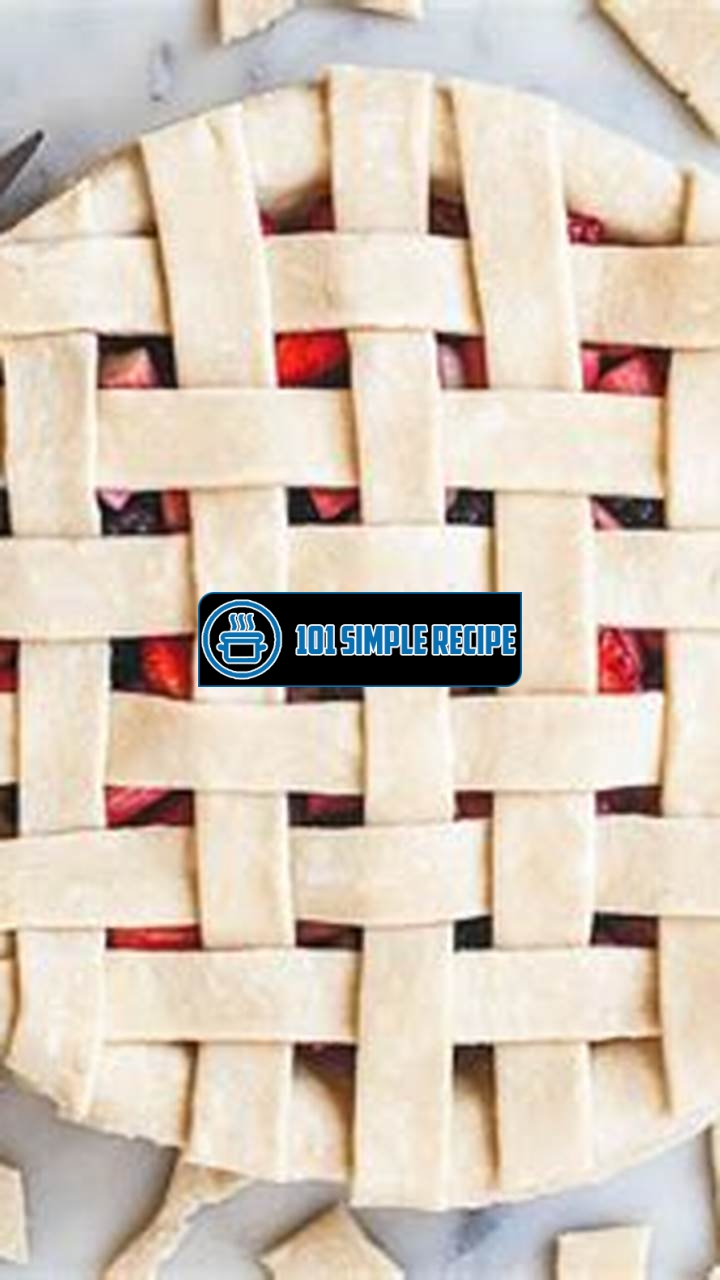If you’ve ever stared at a picture-perfect pie with an intricate lattice top and wondered how on earth it was done, wonder no more! Creating a lattice top for your pie crust may seem like a daunting task, but with a few key tips and tricks, you can achieve bakery-worthy results in no time. Whether you’re a seasoned baker looking to improve your pie game or a beginner seeking to impress your friends and family, mastering the art of a lattice top will take your pie-making skills to the next level. So roll up your sleeves, grab your rolling pin, and get ready to create a pie that looks just as good as it tastes! ✨

Understanding the Basics of Pie Crust
Creating a picture-perfect lattice top for your pie crust requires a solid understanding of the basics. A perfect pie crust consists of key components and techniques that contribute to its flaky and delicious texture. By mastering these fundamentals, you can elevate your pie-making skills to impressive heights.
Importance of a Flaky Pie Crust
A flaky pie crust is essential for a visually appealing lattice top. Not only does it create a beautiful visual effect, but it also adds a delightful mouthfeel to your pie. Achieving the perfect flakiness can be a challenging task, but with the right techniques and ingredients, you can create a crust that is tender, light, and full of flavor.
To achieve a flaky texture, it is crucial to have the right ratio of fat to flour. The fat creates layers within the dough, resulting in the desired flakiness. Additionally, proper handling and technique play a vital role in creating a flaky crust. Overhandling the dough can lead to a tough crust, while underhandling can result in a dense and heavy texture.
Tip: Be gentle when working with the dough to avoid any toughness or heaviness in your final crust.
The Role of Butter in Pie Crust
Butter is a key ingredient in creating a fantastic lattice top for your pie crust. It adds flavor, richness, and contributes to the desired flakiness. When incorporating butter into your dough, it should be cold and cut into small pieces. This allows the butter to mix evenly with the flour, creating small pockets of fat that will melt during baking, resulting in those sought-after flaky layers.
One important factor to consider when using butter in your pie crust is its water content. Butter contains about 15-20% water, which can affect the texture of the dough. It’s essential to use butter that is cold and solid to ensure the water doesn’t distribute too evenly, as it can make the dough too moist.
Tip: Keep your butter cold and use quick, light motions when incorporating it into the flour to maintain the desired flakiness in your pie crust.
Choosing the Right Flour for Your Pie Crust
The type of flour you use can greatly impact the outcome of your lattice top for a pie crust. The ideal flour for pie crust is one with a moderate protein content, around 10-12%. All-purpose flour is a popular choice as it strikes a balance between tenderness and structure. It provides a reliable base for your lattice top, ensuring it holds its shape while remaining tender.
However, if you prefer a flakier texture, you can opt for pastry flour, which has a lower protein content. Pastry flour produces a more delicate crust, perfect for showcasing a beautiful lattice design.
When measuring your flour, it’s crucial to avoid packing it into the measuring cup. Instead, lightly spoon the flour into the cup and level it off with a straight edge. This method avoids compacting the flour, resulting in a more accurate measurement.
By understanding the basics of pie crust, the importance of a flaky texture, the role of butter, and the right flour to use, you can master the art of creating a picture-perfect lattice top for your pie crust. With practice and attention to detail, your pies will become showstoppers that leave everyone craving for more.
Preparing the Lattice Strips
The lattice top is a beautiful and classic way to decorate your pie crust. It may seem daunting at first, but with a step-by-step process, you can easily create picture-perfect lattice strips for your pie crust. In this section, we will guide you through the process of preparing the lattice strips.
Rolling Out the Pie Dough
The first step in creating lattice strips is rolling out the pie dough. Start by dusting your work surface and rolling pin with flour to prevent sticking. Divide the pie dough into two equal portions to ensure there is enough dough for the lattice top as well as the bottom crust. Take one portion and form it into a disc shape.
Place the disc on the floured surface and begin rolling it out with the rolling pin. Roll the dough from the center outward, rotating it a quarter turn after every few rolls to create an even thickness. Aim for a thickness of about 1/8 inch.
Tip: Chilling the pie dough in the refrigerator for about 30 minutes before rolling it out can make the process easier.
Cutting the Strips for the Lattice
Once the pie dough is rolled out, it’s time to cut the strips for the lattice. Use a sharp knife or a pizza cutter to cut even strips of dough. Aim for strips that are about 1/2 to 1 inch wide. You can use a ruler or a straight edge to help guide your cuts and ensure uniformity.
Tip: If you want a thicker lattice pattern, you can cut wider strips. Experiment with different widths to achieve the desired look.
Weaving the Lattice Pattern
With your strips of dough ready, it’s time to weave the lattice pattern. Start by laying a strip of dough horizontally across the center of the pie filling. Leave a small gap between each strip to allow for expansion during baking.
Next, fold back every other strip halfway and place a strip of dough vertically across the unfolded strips. Unfold the folded strips back over the newly placed strip. Repeat this process, alternating which strips are folded back each time, until you have created a woven lattice pattern.
Tip: If any of the strips break or tear while weaving, don’t worry! Pie dough is forgiving, and you can easily patch or reshape the strips as needed.
Creating a picture-perfect lattice top for your pie crust may take some practice, but with these step-by-step instructions, you’ll soon become a pro. Remember to roll out the pie dough evenly, cut uniform strips, and weave them together carefully. So go ahead and impress your friends and family with your beautifully decorated lattice top pie crust!
Arranging the Lattice Top on Your Pie
When it comes to creating a visually stunning lattice top for your pie crust, expertly arranging the lattice strips is key. This technique adds a touch of elegance and artistry to your pie, making it a true showstopper. In this guide, we will walk you through the process step by step, ensuring you master the art of creating a picture-perfect lattice top for your pie crust.
Placing the First Set of Strips
The first step in creating a lattice top for your pie crust is to place the first set of strips. Start by rolling out your pie dough and carefully cutting it into long, thin strips. These strips will serve as the foundation of your lattice design. Begin by laying out an even number of strips horizontally across the pie, leaving a small gap between each strip. This will create the base for weaving the vertical strips.
Note: Be sure to handle the dough gently to avoid stretching or tearing it.
Crossing the Strips to Create a Woven Effect
Now that the foundation is in place, it’s time to create the woven effect that gives a lattice top its signature look. Take one of the remaining strips and place it vertically across the pie, perpendicular to the horizontal strips. Carefully lift every other horizontal strip and fold it back over the vertical strip. Place the folded horizontal strips back down and lift the alternate strips. Repeat this process, weaving the vertical strip over and under the horizontal strips until you reach the end of the pie. Remember to gently press the ends of the strips against the edges of the bottom crust to secure them.
Note: Keep in mind that precision and patience are essential when weaving the lattice strips. Take your time to ensure a neat and symmetrical pattern.
Tip: If you want a tighter weave, use more strips and place them closer together. For a more open design, use fewer strips and leave more space between them.
Finessing the Edges for a Polished Look
Now that your lattice top is complete, it’s time to add the finishing touches to achieve a polished look. Trim any excess dough hanging over the edges of the pie using a sharp knife. Then, use your fingers or a fork to crimp the edges, sealing the lattice top to the bottom crust. This will not only give your pie a professional appearance but also help ensure that the filling stays inside as it bakes.
Note: To prevent the edges from burning during baking, you can cover them with aluminum foil or a pie crust shield.
Tip: For an extra touch of visual appeal, brush the lattice strips with an egg wash before baking. This will give them a beautiful golden brown color.
By following these step-by-step instructions, you can master the art of creating a picture-perfect lattice top for your pie crust. Remember to take your time, be patient, and have fun with the process. With practice, you’ll be able to impress your friends and family with your exceptional pie-making skills!
Baking Tips for a Perfect Lattice Top
When it comes to baking a pie with a lattice top, there are a few key tips and tricks that can help ensure your crust turns out golden and picture-perfect. From applying an egg wash for a beautiful finish to preventing tipping and shrinking of the lattice, mastering the art of creating a lattice top for your pie crust is within reach.
Applying an Egg Wash for a Beautiful Finish
One of the secrets to achieving a beautiful, glossy finish on your lattice top is applying an egg wash. To create the egg wash, simply beat one egg with a tablespoon of water until well combined. Once your lattice top is assembled, use a pastry brush to lightly coat the surface with the egg wash. This will give your crust a lovely golden hue and a professional-looking sheen.
Be sure to brush the egg wash gently over the entire lattice, making sure to reach all the nooks and crannies. This will help the crust cook evenly and give it a consistent color. Don’t forget to also brush the edges of the pie crust to ensure they have that same beautiful finish.
Preventing Tipping and Shrinking of the Lattice
Have you ever baked a lattice top pie only to find that the lattice strips have tipped over or shrunk during baking? To prevent this frustrating issue, there are a few techniques you can employ.
1. Size Matters: Make sure to cut your lattice strips wide enough to withstand the heat of the oven. A good rule of thumb is to cut the strips about 1 inch wide. This will help to minimize shrinking and maintain the lattice’s structure.
2. Gentle Weaving: When weaving the lattice strips, be careful not to pull or stretch them too tightly. This can cause the lattice to contract during baking, resulting in a smaller, misshapen pattern. Aim for a loose, yet secure, weave to maintain the lattice’s integrity.
3. Chilled Dough: It’s essential to work with chilled pie dough when creating your lattice top. This helps to keep the lattice strips firm and prevents them from losing their shape while baking. If the dough becomes too soft or warm, place it back in the refrigerator for a few minutes to firm up. ❄️
Timing and Temperature Guidelines for Baking
Proper timing and temperature are crucial when it comes to baking a perfect lattice top pie crust. Follow these guidelines to achieve the best results:
1. Preheat the Oven: Before placing your pie in the oven, make sure it is fully preheated to the recommended temperature. This ensures that the crust will begin baking immediately, preventing any potential issues with undercooking or uneven browning.
2. Adjust Baking Time: Depending on your recipe and the size of your pie, the baking time may vary. Monitor the pie closely and adjust the baking time as needed, ensuring that the crust is golden brown and the filling is cooked through. It’s better to slightly overbake than to underbake your pie. ⏰
3. Cool and Set: Once your lattice top pie is baked to perfection, allow it to cool and set for at least an hour before serving. This allows the pie to firm up and makes it easier to cut into neat slices without the filling spilling out.
By applying these expert tips and tricks, you can master the art of creating a picture-perfect lattice top for your pie crust. Remember to have patience and practice, and soon you’ll be impressing your friends and family with your beautifully baked lattice top pies. Happy baking!
Creative Variations on Lattice Top Designs
When it comes to creating a picture-perfect lattice top for your pie crust, there are endless possibilities for creative variations. By exploring unique and eye-catching lattice top designs, you can take your pie presentation to the next level and impress your guests with your baking skills. In this article, we will cover three exciting designs: the diagonal lattice design, the braided lattice design, and heart-shaped cutouts for a romantic twist.
Diagonal Lattice Design
The diagonal lattice design adds a modern and dynamic touch to your pie crust. To achieve this design, start by rolling out your pie dough onto a floured surface. Using a sharp knife or a pizza cutter, cut the rolled dough into long, thin strips. Place half of the strips horizontally across the pie filling, leaving an even amount of space between each strip. Then, take the remaining strips and weave them diagonally through the horizontal strips, forming a beautiful lattice pattern.
This design adds visual interest and depth to your pie, making it a showstopper at any gathering.
Braided Lattice Design
To create a braided lattice design, you will need patience and attention to detail. Start by rolling out your pie dough and cutting it into long, thin strips. Take three strips and press them together at one end. Begin braiding the strips by alternating the outer strips over the center strip until you reach the end. Repeat this process with additional strips until you have enough to cover your pie filling.
The braided lattice design adds a touch of elegance and sophistication to your pie. It’s perfect for special occasions or when you want to impress your loved ones.
Heart-shaped Cutouts for a Romantic Twist
If you’re looking to add a romantic twist to your pie, consider using heart-shaped cutouts in your lattice top design. Roll out your pie dough and cut it into long strips. Then, using a small heart-shaped cookie cutter, cut out hearts from the dough strips. Place the strips with the heart-shaped cutouts over your pie filling, weaving them together to form a lattice pattern.
This design is perfect for Valentine’s Day or anniversaries, adding a charming and heartfelt touch to your pie.
By exploring these creative variations on lattice top designs, you can elevate your pie presentation and make it a true work of art. Whether you choose the diagonal lattice design, the braided lattice design, or heart-shaped cutouts for a romantic twist, your pie will surely be the star of the dessert table. So go ahead and unleash your creativity in the kitchen!
Frequently Asked Questions
Here are some frequently asked questions about making a lattice top for a pie crust:
| No. | Questions | Answers |
|---|---|---|
| 1. | What is a lattice top pie crust? | A lattice top pie crust is a decorative arrangement of pie crust strips woven together to create a lattice pattern on top of a pie. |
| 2. | How do I make a lattice top for a pie crust? | To make a lattice top for a pie crust, roll out the pie dough into a large circle, then cut thin strips from it. Lay half of the strips horizontally across the pie filling, then weave the remaining strips vertically through them. Trim the excess dough and press the edges to seal. |
| 3. | Why should I use a lattice top for my pie crust? | A lattice top pie crust not only adds an attractive visual element to your pie, but it also allows steam to escape from the filling, preventing it from becoming too soggy. |
| 4. | Can I use any type of pie filling with a lattice top? | Yes, you can use a lattice top for any type of pie filling, whether it’s fruit-based, custard-based, or even savory. |
| 5. | Do I need any special tools to make a lattice top for a pie crust? | No, you don’t need any special tools. A sharp knife or a pastry wheel for cutting the dough strips and your hands for weaving them together are all you need. |
| 6. | Can I freeze a pie with a lattice top? | Yes, you can freeze a pie with a lattice top. Just make sure to wrap it tightly to prevent freezer burn and thaw it before serving. |
Thanks for reading! Come back for more delicious recipes!
We hope you enjoyed learning how to make a lattice top for a pie crust. The beautiful lattice design adds an extra touch to your homemade pies and allows the filling to cook evenly. Don’t forget to visit our website again for more mouthwatering recipes and tips. Happy baking!
Jump to Recipe
Lattice Top Pie Crust Recipe

Learn how to make a lattice top for a pie crust with this step-by-step guide. Impress your friends and family with beautifully woven pie crust strips.
- 2 1/2 cups all-purpose flour
- 1 teaspoon salt
- 1 cup unsalted butter (cold and cubed)
- 6-8 tablespoons ice water
- In a large mixing bowl, combine the flour and salt. Add the cold cubed butter and use a pastry cutter or your fingers to cut the butter into the flour until it resembles coarse crumbs. Gradually add ice water and mix until the dough comes together. Divide the dough into two equal portions. Shape each portion into a disk, wrap in plastic wrap, and refrigerate for at least 1 hour.
- Take one chilled dough disk and roll it out on a lightly floured surface into a large circle, about 12 inches in diameter. Carefully transfer the rolled out dough to a 9-inch pie dish, pressing it gently into the bottom and sides.
- Take the remaining chilled dough disk and roll it out into a rectangle, about 1/8 inch thick. Use a sharp knife or a pastry wheel to cut thin strips from the dough.
- Lay half of the dough strips horizontally across the pie filling. Weave the remaining strips vertically through the horizontal strips, alternating over and under each strip. Press the edges of the strips to seal them to the bottom crust. Trim any excess dough.
- Preheat the oven to 375°F (190°C). Place the pie on a baking sheet to catch any potential drips. Bake for about 45-50 minutes, or until the crust is golden brown and the filling is bubbling. Allow the pie to cool for at least 2 hours before serving.
- Slice the pie and serve it with your favorite accompaniments. Enjoy your delicious homemade pie with a beautifully woven lattice top!






